INFM 104 - Article Reflection: Library Automation and Collection Mgmt
VerifiedAdded on 2023/05/30
|5
|1095
|207
Report
AI Summary
This report provides a summary and reflection on an article by Marshall Breeding concerning library automation and the challenges of managing diverse collections (digital, electronic, and print). The summary identifies Breeding's expertise and the article's main points, including the state of library automation, technology trends, extending the current model, and a vision for the future. The reflection focuses on the ease of data organization versus the difficulty of documentation and metadata creation. The report emphasizes the importance of data organization in various fields, referencing its application in hospitals. It concludes by highlighting the significance of library automation for users and librarians in managing extensive book collections and visitor data.
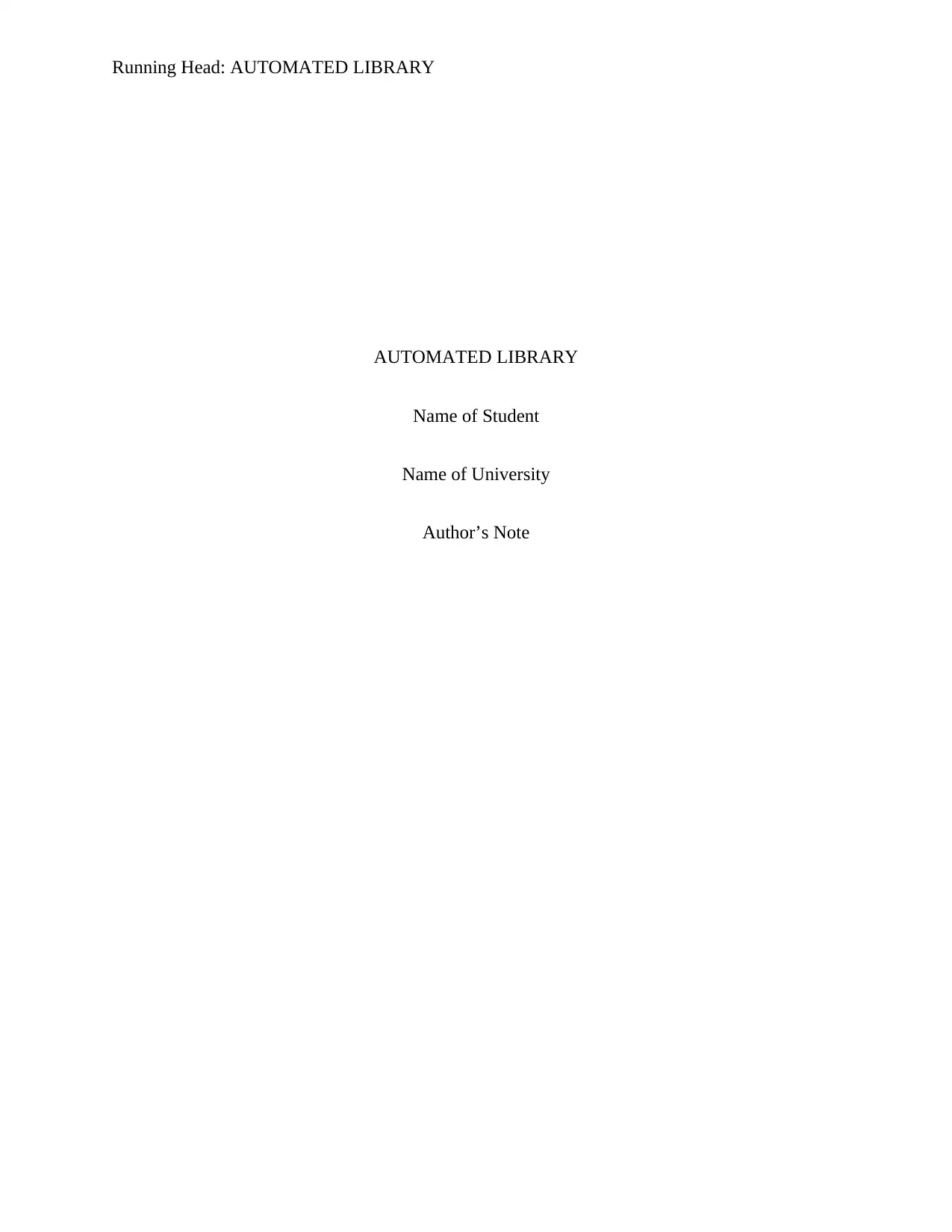
Running Head: AUTOMATED LIBRARY
AUTOMATED LIBRARY
Name of Student
Name of University
Author’s Note
AUTOMATED LIBRARY
Name of Student
Name of University
Author’s Note
Paraphrase This Document
Need a fresh take? Get an instant paraphrase of this document with our AI Paraphraser
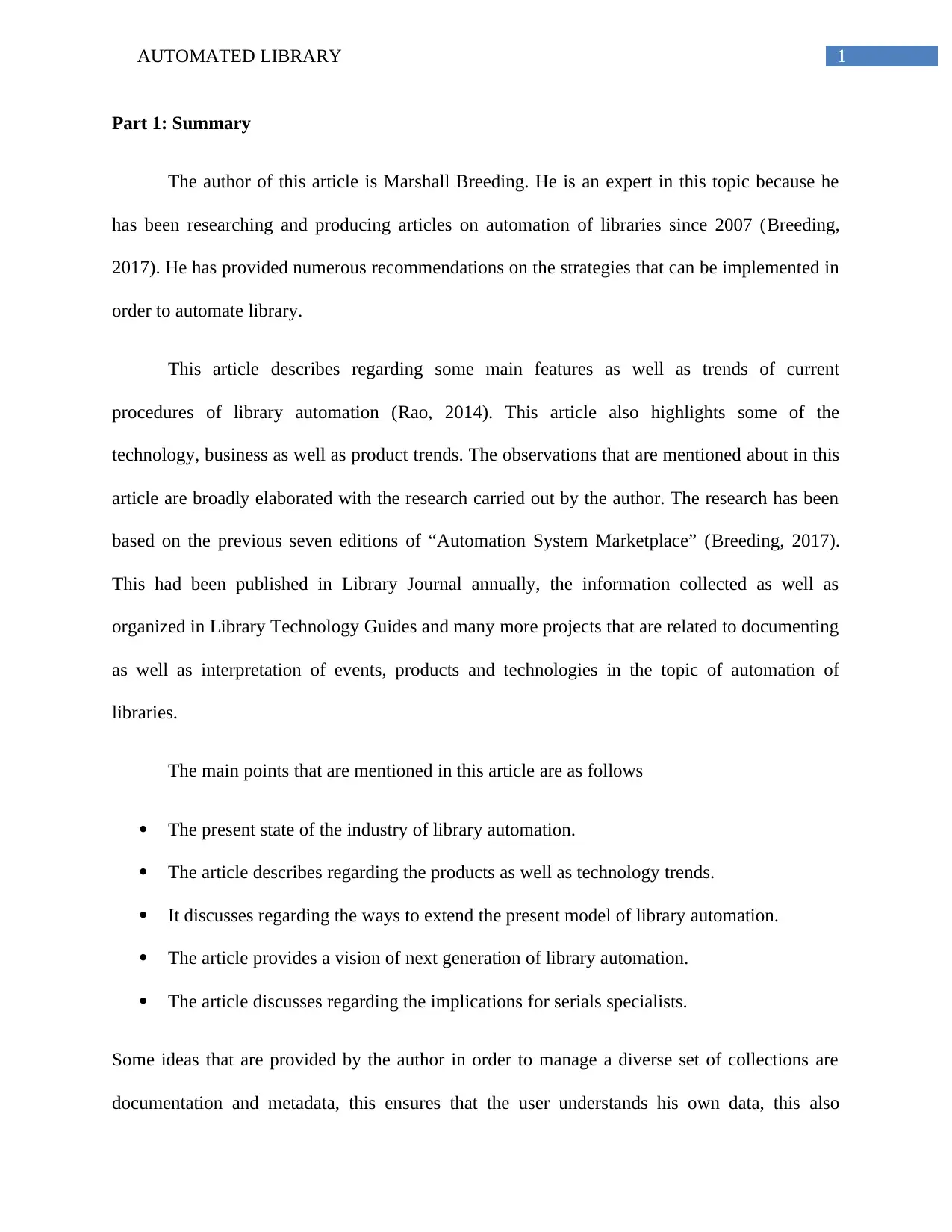
1AUTOMATED LIBRARY
Part 1: Summary
The author of this article is Marshall Breeding. He is an expert in this topic because he
has been researching and producing articles on automation of libraries since 2007 (Breeding,
2017). He has provided numerous recommendations on the strategies that can be implemented in
order to automate library.
This article describes regarding some main features as well as trends of current
procedures of library automation (Rao, 2014). This article also highlights some of the
technology, business as well as product trends. The observations that are mentioned about in this
article are broadly elaborated with the research carried out by the author. The research has been
based on the previous seven editions of “Automation System Marketplace” (Breeding, 2017).
This had been published in Library Journal annually, the information collected as well as
organized in Library Technology Guides and many more projects that are related to documenting
as well as interpretation of events, products and technologies in the topic of automation of
libraries.
The main points that are mentioned in this article are as follows
The present state of the industry of library automation.
The article describes regarding the products as well as technology trends.
It discusses regarding the ways to extend the present model of library automation.
The article provides a vision of next generation of library automation.
The article discusses regarding the implications for serials specialists.
Some ideas that are provided by the author in order to manage a diverse set of collections are
documentation and metadata, this ensures that the user understands his own data, this also
Part 1: Summary
The author of this article is Marshall Breeding. He is an expert in this topic because he
has been researching and producing articles on automation of libraries since 2007 (Breeding,
2017). He has provided numerous recommendations on the strategies that can be implemented in
order to automate library.
This article describes regarding some main features as well as trends of current
procedures of library automation (Rao, 2014). This article also highlights some of the
technology, business as well as product trends. The observations that are mentioned about in this
article are broadly elaborated with the research carried out by the author. The research has been
based on the previous seven editions of “Automation System Marketplace” (Breeding, 2017).
This had been published in Library Journal annually, the information collected as well as
organized in Library Technology Guides and many more projects that are related to documenting
as well as interpretation of events, products and technologies in the topic of automation of
libraries.
The main points that are mentioned in this article are as follows
The present state of the industry of library automation.
The article describes regarding the products as well as technology trends.
It discusses regarding the ways to extend the present model of library automation.
The article provides a vision of next generation of library automation.
The article discusses regarding the implications for serials specialists.
Some ideas that are provided by the author in order to manage a diverse set of collections are
documentation and metadata, this ensures that the user understands his own data, this also
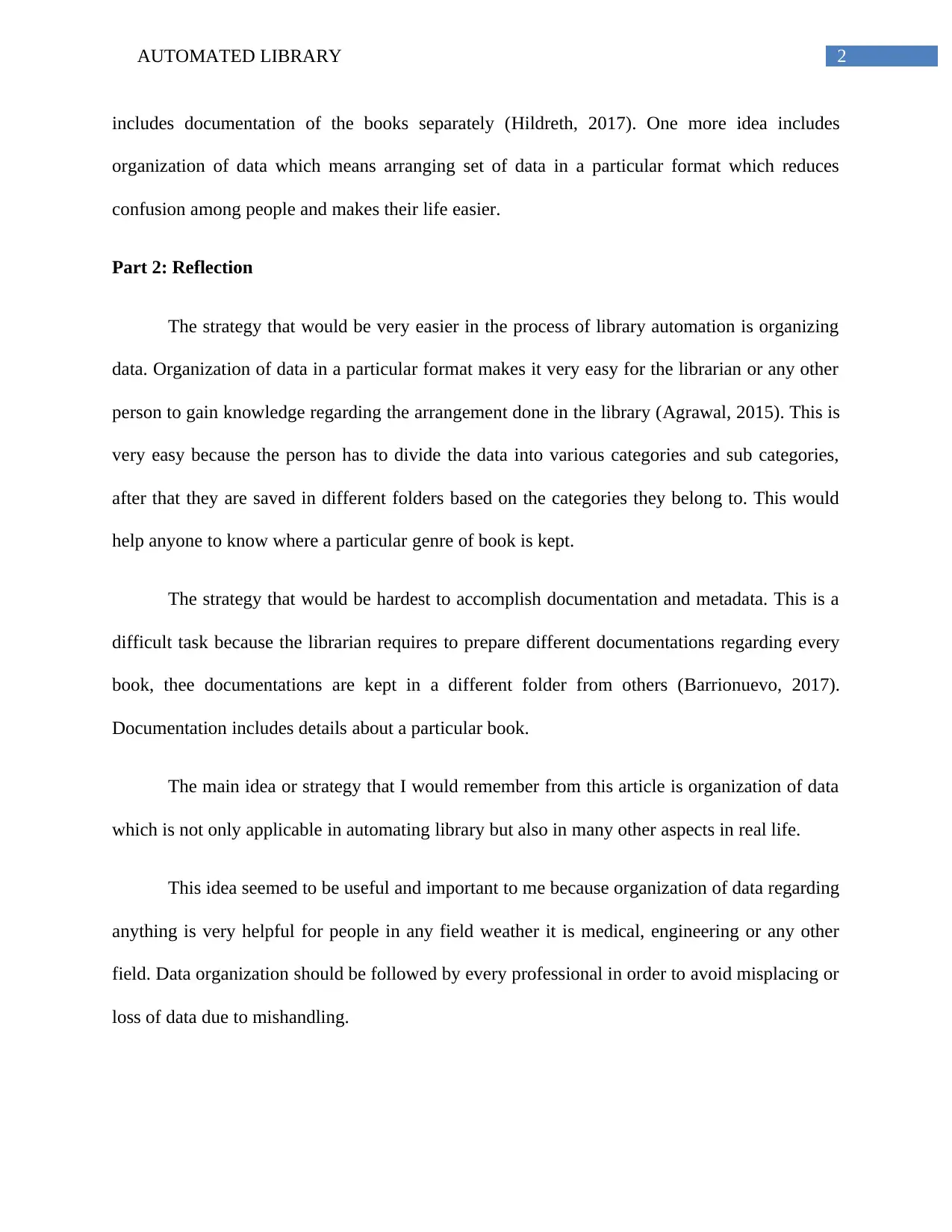
2AUTOMATED LIBRARY
includes documentation of the books separately (Hildreth, 2017). One more idea includes
organization of data which means arranging set of data in a particular format which reduces
confusion among people and makes their life easier.
Part 2: Reflection
The strategy that would be very easier in the process of library automation is organizing
data. Organization of data in a particular format makes it very easy for the librarian or any other
person to gain knowledge regarding the arrangement done in the library (Agrawal, 2015). This is
very easy because the person has to divide the data into various categories and sub categories,
after that they are saved in different folders based on the categories they belong to. This would
help anyone to know where a particular genre of book is kept.
The strategy that would be hardest to accomplish documentation and metadata. This is a
difficult task because the librarian requires to prepare different documentations regarding every
book, thee documentations are kept in a different folder from others (Barrionuevo, 2017).
Documentation includes details about a particular book.
The main idea or strategy that I would remember from this article is organization of data
which is not only applicable in automating library but also in many other aspects in real life.
This idea seemed to be useful and important to me because organization of data regarding
anything is very helpful for people in any field weather it is medical, engineering or any other
field. Data organization should be followed by every professional in order to avoid misplacing or
loss of data due to mishandling.
includes documentation of the books separately (Hildreth, 2017). One more idea includes
organization of data which means arranging set of data in a particular format which reduces
confusion among people and makes their life easier.
Part 2: Reflection
The strategy that would be very easier in the process of library automation is organizing
data. Organization of data in a particular format makes it very easy for the librarian or any other
person to gain knowledge regarding the arrangement done in the library (Agrawal, 2015). This is
very easy because the person has to divide the data into various categories and sub categories,
after that they are saved in different folders based on the categories they belong to. This would
help anyone to know where a particular genre of book is kept.
The strategy that would be hardest to accomplish documentation and metadata. This is a
difficult task because the librarian requires to prepare different documentations regarding every
book, thee documentations are kept in a different folder from others (Barrionuevo, 2017).
Documentation includes details about a particular book.
The main idea or strategy that I would remember from this article is organization of data
which is not only applicable in automating library but also in many other aspects in real life.
This idea seemed to be useful and important to me because organization of data regarding
anything is very helpful for people in any field weather it is medical, engineering or any other
field. Data organization should be followed by every professional in order to avoid misplacing or
loss of data due to mishandling.
⊘ This is a preview!⊘
Do you want full access?
Subscribe today to unlock all pages.

Trusted by 1+ million students worldwide
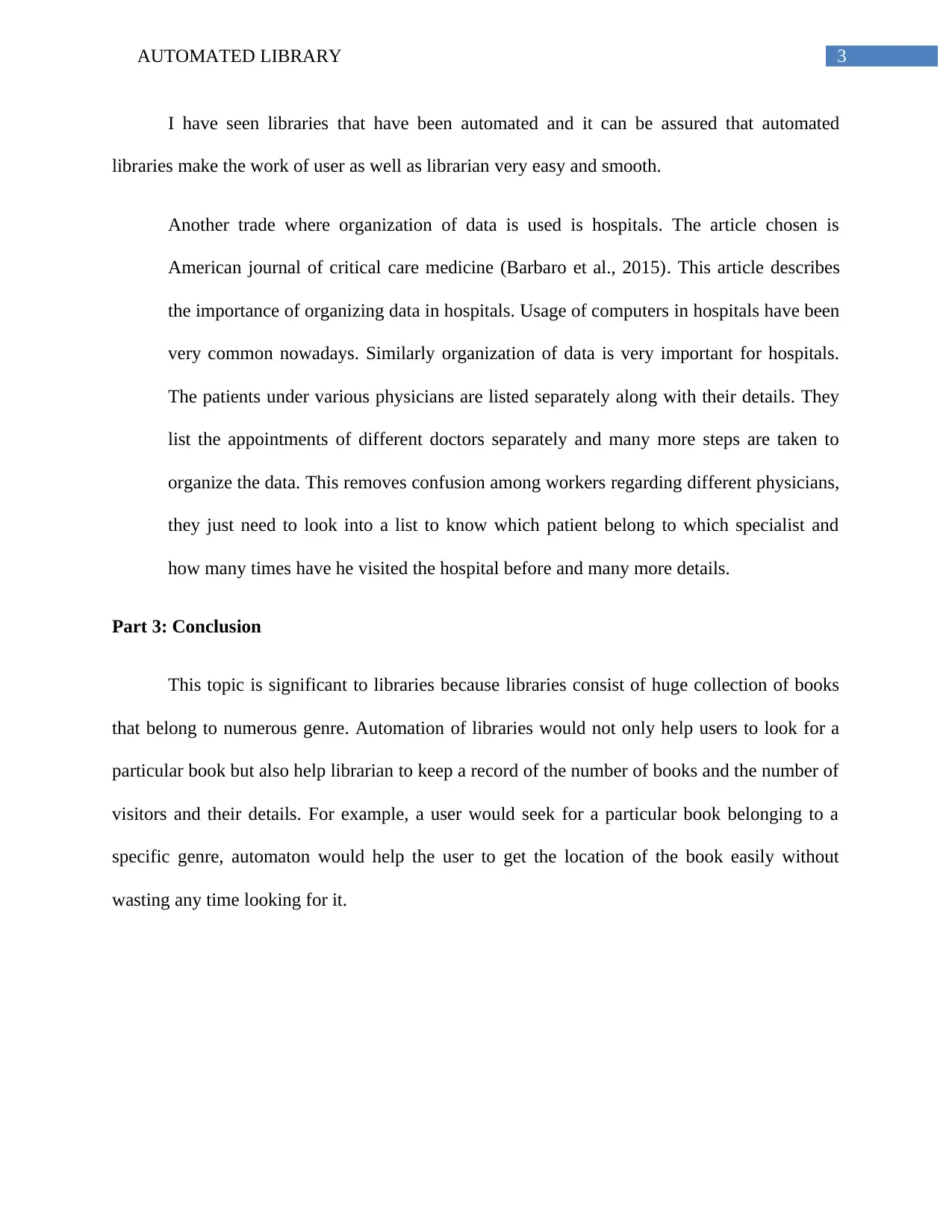
3AUTOMATED LIBRARY
I have seen libraries that have been automated and it can be assured that automated
libraries make the work of user as well as librarian very easy and smooth.
Another trade where organization of data is used is hospitals. The article chosen is
American journal of critical care medicine (Barbaro et al., 2015). This article describes
the importance of organizing data in hospitals. Usage of computers in hospitals have been
very common nowadays. Similarly organization of data is very important for hospitals.
The patients under various physicians are listed separately along with their details. They
list the appointments of different doctors separately and many more steps are taken to
organize the data. This removes confusion among workers regarding different physicians,
they just need to look into a list to know which patient belong to which specialist and
how many times have he visited the hospital before and many more details.
Part 3: Conclusion
This topic is significant to libraries because libraries consist of huge collection of books
that belong to numerous genre. Automation of libraries would not only help users to look for a
particular book but also help librarian to keep a record of the number of books and the number of
visitors and their details. For example, a user would seek for a particular book belonging to a
specific genre, automaton would help the user to get the location of the book easily without
wasting any time looking for it.
I have seen libraries that have been automated and it can be assured that automated
libraries make the work of user as well as librarian very easy and smooth.
Another trade where organization of data is used is hospitals. The article chosen is
American journal of critical care medicine (Barbaro et al., 2015). This article describes
the importance of organizing data in hospitals. Usage of computers in hospitals have been
very common nowadays. Similarly organization of data is very important for hospitals.
The patients under various physicians are listed separately along with their details. They
list the appointments of different doctors separately and many more steps are taken to
organize the data. This removes confusion among workers regarding different physicians,
they just need to look into a list to know which patient belong to which specialist and
how many times have he visited the hospital before and many more details.
Part 3: Conclusion
This topic is significant to libraries because libraries consist of huge collection of books
that belong to numerous genre. Automation of libraries would not only help users to look for a
particular book but also help librarian to keep a record of the number of books and the number of
visitors and their details. For example, a user would seek for a particular book belonging to a
specific genre, automaton would help the user to get the location of the book easily without
wasting any time looking for it.
Paraphrase This Document
Need a fresh take? Get an instant paraphrase of this document with our AI Paraphraser
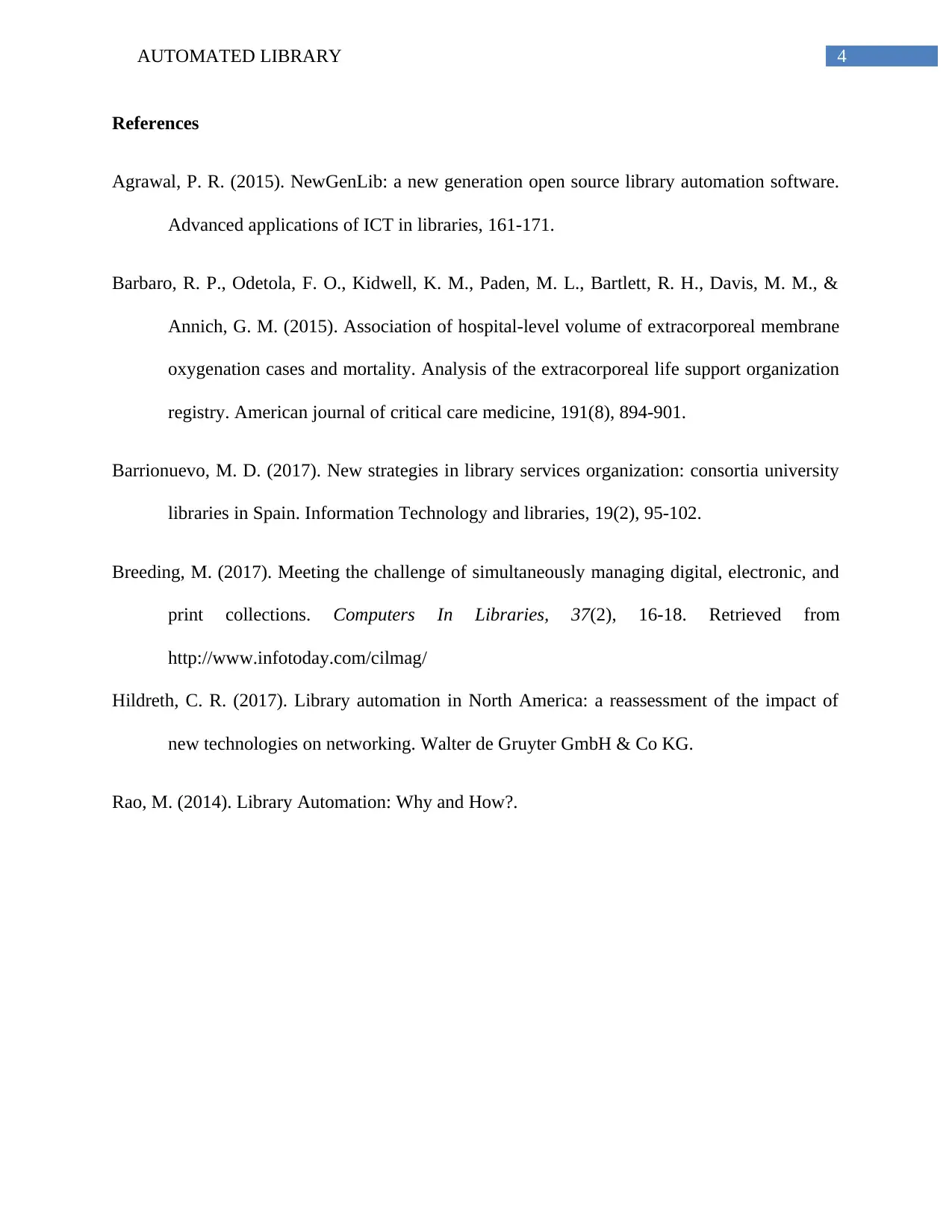
4AUTOMATED LIBRARY
References
Agrawal, P. R. (2015). NewGenLib: a new generation open source library automation software.
Advanced applications of ICT in libraries, 161-171.
Barbaro, R. P., Odetola, F. O., Kidwell, K. M., Paden, M. L., Bartlett, R. H., Davis, M. M., &
Annich, G. M. (2015). Association of hospital-level volume of extracorporeal membrane
oxygenation cases and mortality. Analysis of the extracorporeal life support organization
registry. American journal of critical care medicine, 191(8), 894-901.
Barrionuevo, M. D. (2017). New strategies in library services organization: consortia university
libraries in Spain. Information Technology and libraries, 19(2), 95-102.
Breeding, M. (2017). Meeting the challenge of simultaneously managing digital, electronic, and
print collections. Computers In Libraries, 37(2), 16-18. Retrieved from
http://www.infotoday.com/cilmag/
Hildreth, C. R. (2017). Library automation in North America: a reassessment of the impact of
new technologies on networking. Walter de Gruyter GmbH & Co KG.
Rao, M. (2014). Library Automation: Why and How?.
References
Agrawal, P. R. (2015). NewGenLib: a new generation open source library automation software.
Advanced applications of ICT in libraries, 161-171.
Barbaro, R. P., Odetola, F. O., Kidwell, K. M., Paden, M. L., Bartlett, R. H., Davis, M. M., &
Annich, G. M. (2015). Association of hospital-level volume of extracorporeal membrane
oxygenation cases and mortality. Analysis of the extracorporeal life support organization
registry. American journal of critical care medicine, 191(8), 894-901.
Barrionuevo, M. D. (2017). New strategies in library services organization: consortia university
libraries in Spain. Information Technology and libraries, 19(2), 95-102.
Breeding, M. (2017). Meeting the challenge of simultaneously managing digital, electronic, and
print collections. Computers In Libraries, 37(2), 16-18. Retrieved from
http://www.infotoday.com/cilmag/
Hildreth, C. R. (2017). Library automation in North America: a reassessment of the impact of
new technologies on networking. Walter de Gruyter GmbH & Co KG.
Rao, M. (2014). Library Automation: Why and How?.
1 out of 5
Related Documents
Your All-in-One AI-Powered Toolkit for Academic Success.
+13062052269
info@desklib.com
Available 24*7 on WhatsApp / Email
![[object Object]](/_next/static/media/star-bottom.7253800d.svg)
Unlock your academic potential
Copyright © 2020–2025 A2Z Services. All Rights Reserved. Developed and managed by ZUCOL.




